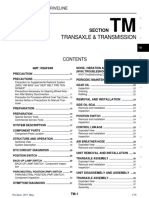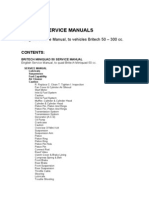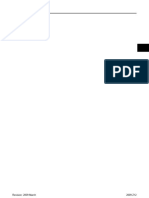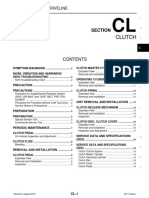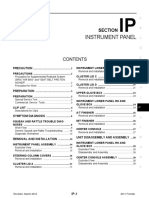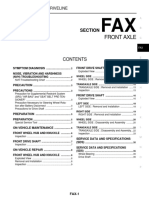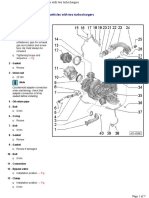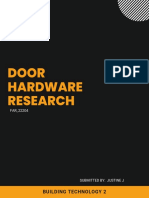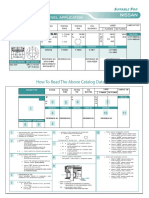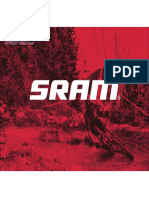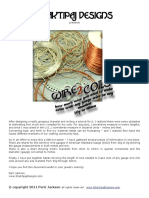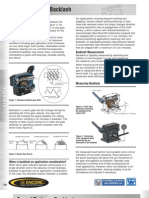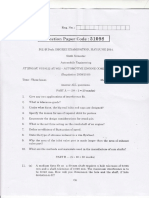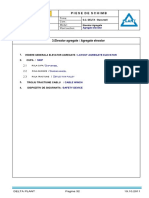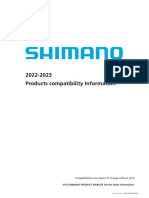Clutch: Section
Clutch: Section
Uploaded by
Hakob AdamyanCopyright:
Available Formats
Clutch: Section
Clutch: Section
Uploaded by
Hakob AdamyanOriginal Title
Copyright
Available Formats
Share this document
Did you find this document useful?
Is this content inappropriate?
Copyright:
Available Formats
Clutch: Section
Clutch: Section
Uploaded by
Hakob AdamyanCopyright:
Available Formats
TRANSMISSION & DRIVELINE
SECTION CL CLUTCH
B
CL
E
CONTENTS
SYMPTOM DIAGNOSIS ............................... 2 Inspection and Adjustment ......................................10 F
NOISE, VIBRATION AND HARSHNESS CLUTCH MASTER CYLINDER ........................ 11
(NVH) TROUBLESHOOTING ............................. 2 Exploded View .........................................................11
G
NVH Troubleshooting Chart ...................................... 2 Removal and Installation .........................................11
Disassembly and Assembly .....................................13
PRECAUTION ............................................... 3 Inspection and Adjustment ......................................14
H
PRECAUTIONS ................................................... 3 CLUTCH PIPING ............................................... 15
Precaution for Supplemental Restraint System Exploded View .........................................................15
(SRS) "AIR BAG" and "SEAT BELT PRE-TEN- Hydraulic Layout ......................................................15 I
SIONER" ................................................................... 3 Removal and Installation .........................................16
Precaution for Procedure without Cowl Top Cover...... 3 Inspection and Adjustment ......................................16
Service Notice or Precautions for Clutch .................. 3
UNIT REMOVAL AND INSTALLATION ...... 17 J
PREPARATION ............................................ 5
CSC (CONCENTRIC SLAVE CYLINDER) ....... 17
PREPARATION ................................................... 5 Exploded View .........................................................17 K
Special Service Tools ................................................ 5 Removal and Installation .........................................17
Commercial Service Tools ........................................ 5 Inspection and Adjustment ......................................20
PERIODIC MAINTENANCE .......................... 6 CLUTCH DISC AND CLUTCH COVER ............ 21 L
Exploded View .........................................................21
CLUTCH PEDAL ................................................. 6 Removal and Installation .........................................21
Inspection and Adjustment ........................................ 6 Inspection ................................................................22 M
CLUTCH FLUID ................................................... 7 SERVICE DATA AND SPECIFICATIONS
Inspection .................................................................. 7 (SDS) ............................................................ 24
Draining ..................................................................... 7 N
Refilling ..................................................................... 7 SERVICE DATA AND SPECIFICATIONS
Air Bleeding Procedure ............................................. 7 (SDS) ................................................................. 24
Clutch Control System .............................................24 O
REMOVAL AND INSTALLATION ................ 9 Clutch Pedal ............................................................24
CLUTCH PEDAL ................................................. 9 Clutch Master Cylinder ............................................24
Clutch Disc ..............................................................24 P
Exploded View .......................................................... 9
Clutch Cover ............................................................24
Removal and Installation ........................................... 9
Revision: 2013 February CL-1 2012 G Sedan
NOISE, VIBRATION AND HARSHNESS (NVH) TROUBLESHOOTING
< SYMPTOM DIAGNOSIS >
SYMPTOM DIAGNOSIS
NOISE, VIBRATION AND HARSHNESS (NVH) TROUBLESHOOTING
NVH Troubleshooting Chart INFOID:0000000007465950
Use the chart below to find the cause of the symptom. The numbers indicate the order of the inspection. If nec-
essary, repair or replace these parts.
CSC (Concentric Slave Cylinder) (Worn, dirty or damaged)
MASTER CYLINDER PISTON CUP (Damaged)
CLUTCH PEDAL (Inspection and adjustment)
DIAPHRAGM SPRING (Out of tip alignment)
CLUTCH DISC (Lack of spline grease)
CLUTCH DISC (Runout is excessive)
DIAPHRAGM SPRING (Damaged)
CLUTCH DISC (Dirty or burned)
PRESSURE PLATE (Distortion)
CLUTCH DISC (Lining broken)
SUSPECTED PARTS (Possible cause)
ENGINE MOUNTING (Loose)
CLUTCH DISC (Out of true)
CLUTCH DISC (Hardened)
CLUTCH DISC (Worn out)
CLUTCH LINE (Air in line)
FLYWHEEL (Distortion)
CLUTCH DISC (Oily)
EM-221
EM-283
CL-17
CL-21
CL-11
CL-6
CL-7
Reference
Clutch grabs/chatters 1 2 2 2 2 2
Clutch pedal spongy 1 2 2
Symptom Clutch noisy 1
Clutch slips 1 2 2 3 4 5
Clutch does not disengage 1 2 3 4 4 4 4 4 4 4 5 5 6
Revision: 2013 February CL-2 2012 G Sedan
PRECAUTIONS
< PRECAUTION >
PRECAUTION A
PRECAUTIONS
Precaution for Supplemental Restraint System (SRS) "AIR BAG" and "SEAT BELT B
PRE-TENSIONER" INFOID:0000000007465951
The Supplemental Restraint System such as “AIR BAG” and “SEAT BELT PRE-TENSIONER”, used along C
with a front seat belt, helps to reduce the risk or severity of injury to the driver and front passenger for certain
types of collision. This system includes seat belt switch inputs and dual stage front air bag modules. The SRS
system uses the seat belt switches to determine the front air bag deployment, and may only deploy one front
air bag, depending on the severity of a collision and whether the front occupants are belted or unbelted. CL
Information necessary to service the system safely is included in the “SRS AIR BAG” and “SEAT BELT” of this
Service Manual.
WARNING: E
Always observe the following items for preventing accidental activation.
• To avoid rendering the SRS inoperative, which could increase the risk of personal injury or death in
the event of a collision that would result in air bag inflation, all maintenance must be performed by
F
an authorized NISSAN/INFINITI dealer.
• Improper maintenance, including incorrect removal and installation of the SRS, can lead to personal
injury caused by unintentional activation of the system. For removal of Spiral Cable and Air Bag
Module, see “SRS AIR BAG”. G
• Never use electrical test equipment on any circuit related to the SRS unless instructed to in this Ser-
vice Manual. SRS wiring harnesses can be identified by yellow and/or orange harnesses or harness
connectors. H
PRECAUTIONS WHEN USING POWER TOOLS (AIR OR ELECTRIC) AND HAMMERS
WARNING:
Always observe the following items for preventing accidental activation. I
• When working near the Air Bag Diagnosis Sensor Unit or other Air Bag System sensors with the
ignition ON or engine running, never use air or electric power tools or strike near the sensor(s) with
a hammer. Heavy vibration could activate the sensor(s) and deploy the air bag(s), possibly causing J
serious injury.
• When using air or electric power tools or hammers, always switch the ignition OFF, disconnect the
battery, and wait at least 3 minutes before performing any service.
K
Precaution for Procedure without Cowl Top Cover INFOID:0000000007465953
When performing the procedure after removing cowl top cover, cover
L
the lower end of windshield with urethane, etc to prevent damage to
windshield.
PIIB3706J
O
Service Notice or Precautions for Clutch INFOID:0000000007465954
WARNING: P
After cleaning clutch disc, wipe it with a dust collector. Never use compressed air.
CAUTION:
• Clutch fluid use refer to MA-17, "FOR NORTH AMERICA : Fluids and Lubricants".
• Never reuse drained clutch fluid.
• Keep painted surface on the body or other parts free of clutch fluid. If it spills, wipe up immediately
and wash the affected area with water.
• When removing clutch tube, use a flare nut wrench.
Revision: 2013 February CL-3 2012 G Sedan
PRECAUTIONS
< PRECAUTION >
• When installing clutch tube, use a flare nut torque wrench
[Commercial service tool].
• Use new clutch fluid to clean or wash all parts of master cylin-
der.
• Never use mineral oils such as gasoline or kerosene. It will
ruin the rubber parts of the hydraulic system.
• Never reuse CSC (Concentric Slave Cylinder) body and CSC
tube. Because CSC slides back to the original position every
time when removing transmission assembly. At this timing,
dust on the sliding parts may damage a seal of CSC and may
cause clutch fluid leakage. Refer to CL-17, "Removal and
SBR686C
Installation".
• Never disassemble CSC body.
Revision: 2013 February CL-4 2012 G Sedan
PREPARATION
< PREPARATION >
PREPARATION A
PREPARATION
Special Service Tools INFOID:0000000007465955
B
The actual shapes of Kent-Moore tools may differ from those of special service tools illustrated here.
Tool number
(Kent-Moore No.) Description C
Tool name
ST20050240 Adjusting unevenness of diaphragm spring le-
(-) ver CL
Diaphragm adjusting wrench
ZZA0508D
F
Commercial Service Tools INFOID:0000000007465956
G
Tool name Description
Flare nut torque wrench Installing clutch tube
1. Flare nut crowfoot
a: 10 mm (0.39 in)
H
2. Torque wrench
S-NT360
Clutch aligner Installing clutch disc J
MCIB0404E L
Drift Removing bushing
a: 10 mm (0.39 in) dia.
M
N
S-NT063
Power tool Loosening bolts and nuts
O
PBIC0190E
Revision: 2013 February CL-5 2012 G Sedan
CLUTCH PEDAL
< PERIODIC MAINTENANCE >
PERIODIC MAINTENANCE
CLUTCH PEDAL
Inspection and Adjustment INFOID:0000000007465957
INSPECTION
1. Make sure that clevis pin (1) floats freely in the bore of clutch
pedal. It should not be bound by clevis or clutch pedal.
a. If clevis pin is not free, make sure that ASCD clutch switch (2) is
not applying pressure to clutch pedal causing clevis pin to bind.
To adjust, loosen lock nut (3) and turn ASCD clutch switch.
b. Tighten lock nut. Refer to CL-9, "Exploded View".
c. Make sure that clevis pin floats in the bore of clutch pedal. It
should not be bound by clutch pedal.
d. If clevis pin is still not free, remove clevis pin and check for
deformation or damage. Replace clevis pin if necessary. Leave JPDIB0001ZZ
clevis pin removed for step 2.
2. Check clutch pedal stroke for free range of movement.
a. With clevis pin removed, manually move clutch pedal up and down to determine if it moves freely.
b. If any sticking is found, replace related parts (bushing, clutch pedal, etc.). Reassemble clutch pedal and
again make sure that clevis pin floats freely in the bore of clutch pedal.
3. Check clutch hydraulic and system components (clutch master cylinder, CSC, etc.) for sticking or binding.
a. If any sticking or binding is found, repair or replace related parts as necessary.
b. If hydraulic system repair was necessary, bleed the clutch hydraulic system. Refer to CL-7, "Air Bleeding
Procedure".
NOTE:
Do not use a vacuum assist or any other type of power bleeder on this system. Use of vacuum assist or
power bleeder will not purge all the air from the system.
ADJUSTMENT
1. Adjust clutch interlock switch (1) position so that clearance
between stopper rubber (2) and thread end (A) of clutch inter-
lock switch with clutch pedal depressed is clearance “C”.
Standard value
Clearance “C” : Refer to CL-24, "Clutch Pedal".
2. After adjusting clearance “C”, tighten lock nut (3) to the specified
torque. Refer to CL-9, "Exploded View".
JPDIB0002ZZ
Revision: 2013 February CL-6 2012 G Sedan
CLUTCH FLUID
< PERIODIC MAINTENANCE >
CLUTCH FLUID
A
Inspection INFOID:0000000007465958
FLUID LEAKAGE B
• Check clutch line (tubes and hoses) for cracks, deterioration or other damage. Replace any damaged parts.
• Check for fluid leakage by fully depressing clutch pedal while engine is running.
CAUTION: C
If leakage occurs around joints, retighten or, if necessary, replace damaged parts.
FLUID LEVEL
• Check that the fluid level in the reservoir tank is within the specified CL
range (MAX – MIN lines).
• Visually check for any fluid leakage around the reservoir tank.
• Check the clutch system for any leakage if the fluid level is
E
extremely low (lower than MIN).
JPDIB0032ZZ G
Draining INFOID:0000000007465959
CAUTION: H
Keep painted surface on the body or other parts free of clutch fluid. If it spills, wipe up immediately
and wash the affected area with water.
1. Connect a transparent vinyl hose to air bleeder valve. I
2. Depress clutch pedal and loosen air bleeder valve to gradually
discharge clutch fluid.
J
JPDIB0006ZZ L
Refilling INFOID:0000000007465960
CAUTION: M
Keep painted surface on the body or other parts free of clutch fluid. If it spills, wipe up immediately
and wash the affected area with water.
1. Check that there is no foreign material in reservoir tank and then fill with new clutch fluid. N
CAUTION:
Never reuse drained clutch fluid.
2. Loosen air bleeder valve, slowly depress clutch pedal to the full stroke and then release clutch pedal. O
3. Repeat this operation at intervals of 2 or 3 seconds until new clutch fluid is discharged.
4. Tighten air bleeder valve with the clutch pedal depressed.
5. Perform the air bleeding. Refer to CL-7, "Air Bleeding Procedure". P
Air Bleeding Procedure INFOID:0000000007465961
CAUTION:
• Monitor clutch fluid level in reservoir tank to make sure it does not empty.
• Keep painted surface on the body or other parts free of clutch fluid. If it spills, wipe up immediately
and wash the affected area with water.
Revision: 2013 February CL-7 2012 G Sedan
CLUTCH FLUID
< PERIODIC MAINTENANCE >
NOTE:
Do not use a vacuum assist or any other type of power bleeder on this system. Use of vacuum assist or power
bleeder will not purge all the air from the system.
1. Fill master cylinder reservoir tank with new clutch fluid.
CAUTION:
Never reuse drained clutch fluid.
2. Connect a transparent vinyl hose to air bleeder valve.
3. Depress clutch pedal slowly and fully several times at an interval
of 2 to 3 seconds and hold it.
4. With clutch pedal depressed, loosen air bleeder valve to release
air.
5. Tighten air bleeder valve.
6. Release clutch pedal and wait for 5 seconds. JPDIB0006ZZ
7. Repeat steps 3 to 6 until no bubbles can be observed in clutch
fluid.
8. Tighten air bleeder valve to the specified torque. Refer to CL-17, "Exploded View".
9. Check that the fluid level in the reservoir tank is within the specified range after air bleeding. Refer to CL-
7, "Inspection".
Revision: 2013 February CL-8 2012 G Sedan
CLUTCH PEDAL
< REMOVAL AND INSTALLATION >
REMOVAL AND INSTALLATION A
CLUTCH PEDAL
Exploded View INFOID:0000000007465962
B
CL
JPDIB0142GB J
1. ASCD clutch switch 2. Clevis pin 3. Bushing
4. Stopper rubber 5. Pedal pad 6. Pedal stopper rubber
K
7. Snap pin 8. Clutch interlock switch 9. Clutch pedal
: Apply lithium-based grease including molybdenum disulphide.
: Refer to CL-11, "Exploded View" for the tightening torque. L
Refer to GI-4, "Components" for symbols not described on the above.
Removal and Installation INFOID:0000000007465963
M
REMOVAL
1. Remove front kicking plate inner and dash side finisher. Refer to INT-14, "Removal and Installation". N
2. Remove instrument lower panel LH. Refer to IP-23, "M/T MODELS : Removal and Installation".
3. Remove bracket (1) and harness bracket (2).
4. Disconnect ASCD clutch switch and clutch interlock switch con- O
nectors and then remove clip of harness from clutch pedal.
5. Remove snap pin and clevis pin from clevis.
6. Remove ASCD clutch switch, clutch interlock switch, and pedal P
pad from clutch pedal.
7. Remove stopper rubbers and pedal stopper rubber from clutch
pedal, using a suitable remover.
8. Remove clutch pedal from the vehicle.
9. Remove bushing from clutch pedal, using a suitable drift [Com- JPDIB0005ZZ
mercial service tool].
Revision: 2013 February CL-9 2012 G Sedan
CLUTCH PEDAL
< REMOVAL AND INSTALLATION >
INSTALLATION
Note the following, and install in the reverse order of removal.
• Apply recommended grease to bushing.
• Apply recommended grease to clevis pin.
Inspection and Adjustment INFOID:0000000007465964
INSPECTION AFTER REMOVAL
Check the following items and replace clutch pedal if necessary.
• Check clutch pedal upper rivets (A) for deformation.
: Vehicle front
• Check the lapping length “L” of sub-bracket (B) and slide plate (C).
Lapping length “L” : More than 5 mm (0.20 in)
• Check clutch pedal for bend, damage, and cracks on the welded
parts.
JPDIB0153ZZ
INSPECTION AFTER INSTALLATION
Check the clutch pedal free play. Refer to CL-6, "Inspection and Adjustment".
ADJUSTMENT AFTER INSTALLATION
Adjust the clutch interlock switch position. Refer to CL-6, "Inspection and Adjustment".
Revision: 2013 February CL-10 2012 G Sedan
CLUTCH MASTER CYLINDER
< REMOVAL AND INSTALLATION >
CLUTCH MASTER CYLINDER
A
Exploded View INFOID:0000000007465965
CL
I
JPDIB0180GB
1. Bracket 2. Reservoir tank 3. Hose J
4. Master cylinder 5. Packing 6. Clutch pedal
7. Return spring 8. Piston 9. Push rod
10. Stopper ring 11. Boot 12. Clevis K
13. Snap pin 14. Clevis pin
1: Apply rubber lubricant.
L
2: Apply silicone grease.
3: Apply lithium-based grease including molybdenum disulphide.
Refer to GI-4, "Components" for symbols not described on the above.
M
Removal and Installation INFOID:0000000007465966
CAUTION: N
Keep painted surface on the body or other parts free of clutch fluid. If it spills, wipe up immediately
and wash the affected area with water.
REMOVAL O
1. Drain clutch fluid. Refer to CL-7, "Draining".
2. Remove brake master cylinder cover. Refer to EXT-24, "Removal and Installation".
P
3. Remove brake booster pressure sensor. Refer to BR-41, "Removal and Installation".
Revision: 2013 February CL-11 2012 G Sedan
CLUTCH MASTER CYLINDER
< REMOVAL AND INSTALLATION >
4. Remove mounting bolts ( ) and then remove reservoir tank
assembly from the vehicle.
: Vehicle front
5. Remove hose and clips from reservoir tank and master cylinder.
6. Remove reservoir tank mounting bolts and washers and then
remove bracket from reservoir tank.
7. Remove ABS actuator and electric unit (control unit). Refer to
BR-26, "FRONT : Removal and Installation".
JPDIB0109ZZ
8. Remove clutch tube from master cylinder, using a flare nut
wrench.
9. Remove front kicking plate inner and dash side finisher. Refer to INT-14, "Removal and Installation".
10. Remove instrument lower panel LH. Refer to IP-23, "M/T MODELS : Removal and Installation".
11. Remove snap pin and clevis pin from clevis and then separate clevis from clutch pedal.
12. Remove master cylinder mounting nuts and then remove pack-
ing (1) and master cylinder assembly (2) from the vehicle.
: Vehicle front
CAUTION:
Never damage packing, brake booster, and dash lower.
JPDIB0159ZZ
INSTALLATION
1. Install packing (1) and master cylinder assembly (2) to the vehi-
cle.
: Vehicle front
CAUTION:
• Never damage packing, brake booster, and dash lower.
JPDIB0159ZZ
• Be careful with the orientation of packing. The figure is
the view from the vehicle forward.
2. Tighten master cylinder mounting nuts to the specified torque.
3. Connect clutch tube to master cylinder and then temporarily
tighten clutch tube flare nut, using a flare nut wrench.
4. Set clevis to clutch pedal.
5. Apply recommended grease to clevis pin and then install clevis
pin to clevis.
6. Install snap pin to clevis pin.
7. Install instrument lower panel LH. Refer to IP-23, "M/T MODELS JPDIB0010ZZ
: Removal and Installation".
8. Install dash side finisher and front kicking plate inner. Refer to INT-14, "Removal and Installation".
9. Tighten clutch tube flare nut to the specified torque, using a flare nut torque wrench [Commercial service
tool]. Refer to CL-15, "Exploded View".
CAUTION:
Never damage flare nut and clutch tube.
Revision: 2013 February CL-12 2012 G Sedan
CLUTCH MASTER CYLINDER
< REMOVAL AND INSTALLATION >
10. Install ABS actuator and electric unit (control unit). Refer to BR-26, "FRONT : Removal and Installation".
11. Install washers to reservoir tank mounting bolts. A
12. Install bracket to reservoir tank and then tighten reservoir tank mounting bolts to the specified torque.
13. Install hose (1) and clips to reservoir tank (2) and master cylin-
der (3). B
: Painted mark
C
CAUTION:
Set hose with painted mark facing upward.
CL
JPDIB0126ZZ
E
14. Install reservoir tank assembly to the vehicle and then tighten
mounting bolts ( ) to the specified torque.
F
: Vehicle front
15. Install brake booster pressure sensor. Refer to BR-41, "Removal
G
and Installation".
16. Install brake master cylinder cover. Refer to EXT-24, "Removal
and Installation".
H
17. Fill with clutch fluid. Refer to CL-7, "Refilling".
JPDIB0109ZZ
Disassembly and Assembly INFOID:0000000007465967
I
DISASSEMBLY
1. Remove clevis and push rod lock nut from push rod. J
2. Remove boot from master cylinder.
3. Remove stopper ring from master cylinder while holding push
rod. K
4. Remove push rod, piston, and return spring from master cylin-
der.
L
JPDIB0013ZZ
N
ASSEMBLY
1. Apply rubber lubricant to the internal surface of master cylinder, the sliding surface and piston cup of pis-
ton.
O
2. Install return spring and piston to master cylinder.
3. Apply silicon grease to push rod.
4. Install push rod to master cylinder. P
5. Install stopper ring to master cylinder while holding push rod.
CAUTION:
Never reuse stopper ring.
6. Install boot to master cylinder.
7. Install push rod lock nut and clevis to push rod.
Revision: 2013 February CL-13 2012 G Sedan
CLUTCH MASTER CYLINDER
< REMOVAL AND INSTALLATION >
8. Adjust the length “L” between clevis (1) and master cylinder (2)
to the standard value.
Length “L” between clevis : Refer to CL-24, "Clutch
and master cylinder Master Cylinder".
NOTE:
Clutch pedal height is controlled with position of clevis and mas-
ter cylinder.
9. Tighten push rod lock nut (3) to the specified torque.
JPDIB0125ZZ
Inspection and Adjustment INFOID:0000000007465968
INSPECTION AFTER DISASSEMBLY
Check for any of the conditions shown below. If any malfunction is found, replace the part concerned.
• Damaged cylinder internal wall, foreign matter, wear, corrosion, or pinhole.
• Damaged or deformed reservoir tank.
• Settling of return spring.
• Cracked or deformed boot.
• Cracked or deformed packing.
ADJUSTMENT BEFORE INSTALLATION
1. Check the length “L” between clevis (1) and master cylinder (2).
Length “L” between clevis : Refer to CL-24, "Clutch
and master cylinder Master Cylinder".
2. If measurement is outside the standard value, adjust the length
“L” between clevis and master cylinder to the standard value.
3. Tighten push rod lock nut (3) to the specified torque.
JPDIB0125ZZ
INSPECTION AFTER INSTALLATION
• Check the fluid leakage and the fluid level. Refer to CL-7, "Inspection".
• Check the clutch pedal free play. Refer to CL-6, "Inspection and Adjustment".
ADJUSTMENT AFTER INSTALLATION
• Adjust the clutch interlock switch position. Refer to CL-6, "Inspection and Adjustment".
• Perform the air bleeding. Refer to CL-7, "Air Bleeding Procedure".
Revision: 2013 February CL-14 2012 G Sedan
CLUTCH PIPING
< REMOVAL AND INSTALLATION >
CLUTCH PIPING
A
Exploded View INFOID:0000000007465969
CL
J
JPDIB0152GB
1. CSC (Concentric Slave Cylinder) as- 2. Bracket 3. Clutch hose K
sembly
4. Lock plate 5. Clutch tube 6. Connector
7. Master cylinder assembly L
Refer to GI-4, "Components" for the symbols in the figure.
Hydraulic Layout INFOID:0000000007465970
M
P
JPDIB0016ZZ
1. CSC (Concentric Slave Cylinder) as- 2. Clutch tube 3. Clutch hose
sembly
4. Connector 5. Master cylinder assembly
Revision: 2013 February CL-15 2012 G Sedan
CLUTCH PIPING
< REMOVAL AND INSTALLATION >
Removal and Installation INFOID:0000000007465971
CAUTION:
Keep painted surface on the body or other parts free of clutch fluid. If it spills, wipe up immediately
and wash the affected area with water.
REMOVAL
Note the following, and refer to CL-15, "Exploded View" for removal procedure.
• Drain clutch fluid. Refer to CL-7, "Draining".
• Remove clutch tube, using a flare nut wrench.
CAUTION:
Never damage flare nut and clutch tube.
INSTALLATION
Note the following, and refer to CL-15, "Exploded View" for installation procedure.
• To fix clutch hose on bracket, position clutch hose clasp on the
emboss of bracket and drive lock plate vertically from above.
CAUTION:
• Never bend or twist clutch hose.
• Never scratch or damage clutch hose.
• Tighten clutch tube flare nut to the specified torque, using a flare
nut torque wrench [Commercial service tool].
CAUTION:
Never damage flare nut and clutch tube.
• Fill with clutch fluid. Refer to CL-7, "Refilling".
PCIB0681E
Inspection and Adjustment INFOID:0000000007465972
INSPECTION AFTER INSTALLATION
Check the fluid leakage and the fluid level. Refer to CL-7, "Inspection".
ADJUSTMENT AFTER INSTALLATION
Perform the air bleeding. Refer to CL-7, "Air Bleeding Procedure".
Revision: 2013 February CL-16 2012 G Sedan
CSC (CONCENTRIC SLAVE CYLINDER)
< UNIT REMOVAL AND INSTALLATION >
UNIT REMOVAL AND INSTALLATION A
CSC (CONCENTRIC SLAVE CYLINDER)
Exploded View INFOID:0000000007465973
B
CL
JPDIB0127GB J
1. Transmission assembly 2. CSC (Concentric Slave Cylinder) 3. Dust cover
body
K
4. CSC (Concentric Slave Cylinder) 5. Air bleeder valve 6. Bracket
tube
Refer to GI-4, "Components" for the symbols in the figure.
L
Removal and Installation INFOID:0000000007465974
CAUTION: M
• Never reuse CSC (Concentric Slave Cylinder) body and CSC tube. Because CSC slides back to the
original position every time when removing transmission assembly. At this timing, dust on the slid-
ing parts may damage a seal of CSC and may cause clutch fluid leakage.
• Never disassemble CSC body. N
• Keep painted surface on the body or other parts free of clutch fluid. If it spills, wipe up immediately
and wash the affected area with water.
REMOVAL O
1. Remove transmission assembly from the engine. Refer to TM-28, "Removal and Installation".
P
Revision: 2013 February CL-17 2012 G Sedan
CSC (CONCENTRIC SLAVE CYLINDER)
< UNIT REMOVAL AND INSTALLATION >
2. Remove mounting bolt ( ).
JPDIB0012ZZ
3. Pull up the lock pin of the CSC body.
JPDIB0019ZZ
4. Pull out the CSC tube (1) from the CSC body (2).
5. Remove CSC tube and dust cover from transmission case.
6. Remove air bleeder valve and bracket from CSC tube.
JPDIB0031ZZ
7. Remove CSC body from transmission case.
JPDIB0020ZZ
INSTALLATION
Revision: 2013 February CL-18 2012 G Sedan
CSC (CONCENTRIC SLAVE CYLINDER)
< UNIT REMOVAL AND INSTALLATION >
1. Install CSC body to transmission case and then tighten mount-
ing bolts ( ) to the specified torque. A
CAUTION:
• Never reuse CSC body.
• Never insert and operate CSC body because piston and B
stopper of CSC body components may fall off.
JPDIB0020ZZ
CL
2. Install dust cover to transmission case.
: Vehicle front E
CAUTION:
Be careful with the orientation of dust cover.
3. Insert CSC tube to dust cover. F
CAUTION:
• Never reuse CSC tube.
• Never damage O-ring of CSC tube.
G
JPDIB0021ZZ
4. Press down the lock pin of the CSC body.
H
JPDIB0023ZZ
K
5. Insert the CSC tube (1) into the connector of the CSC body (2)
until it clicks.
L
N
JPDIB0031ZZ
6. Install bracket and mounting bolts ( ) and then tighten mount- O
ing bolts to the specified torque in the numerical order as shown
in the figure.
P
JPDIB0129ZZ
Revision: 2013 February CL-19 2012 G Sedan
CSC (CONCENTRIC SLAVE CYLINDER)
< UNIT REMOVAL AND INSTALLATION >
CAUTION:
• Check that CSC tube’s (B) and bracket (1) are fit tightly
before tightening the mounting bolt (A).
• Tighten the mounting bolt within the range of bracket’s
mounting hole.
• After replacing the CSC tube, the mounting bolt (C) is still
temporary tightening. Never forget tightening the mount-
ing bolt.
7. Install air bleeder valve to CSC tube and then tighten air bleeder
valve to the specified torque.
8. Install transmission assembly to the engine. Refer to TM-28,
"Removal and Installation". JPDIB0128ZZ
Inspection and Adjustment INFOID:0000000007465975
INSPECTION AFTER INSTALLATION
Check the fluid leakage and the fluid level. Refer to CL-7, "Inspection".
ADJUSTMENT AFTER INSTALLATION
Perform the air bleeding. Refer to CL-7, "Air Bleeding Procedure".
Revision: 2013 February CL-20 2012 G Sedan
CLUTCH DISC AND CLUTCH COVER
< UNIT REMOVAL AND INSTALLATION >
CLUTCH DISC AND CLUTCH COVER
A
Exploded View INFOID:0000000007465976
CL
G
JPDIB0024GB
1. Flywheel 2. Clutch disc 3. Clutch cover
4. Main drive gear
H
A. First step B. Final step
: Replace the parts as a set.
I
: Apply lithium-based grease including molybdenum disulphide.
Refer to GI-4, "Components" for symbols not described on the above.
J
Removal and Installation INFOID:0000000007465977
CAUTION:
• Never reuse CSC (Concentric Slave Cylinder) body and CSC tube. Because CSC slides back to the K
original position every time when removing transmission assembly. At this timing, dust on the slid-
ing parts may damage a seal of CSC and may cause clutch fluid leakage. Refer to CL-17, "Removal
and Installation". L
• Never bring any grease to the clutch disc facing, pressure plate surface and flywheel surface.
• Never clean clutch disc using solvent.
If flywheel is removed, align dowel pin with the smallest hole of flywheel. Refer to EM-274, "Disassembly and
Assembly". M
REMOVAL
1. Remove transmission assembly from the engine. Refer to TM-28, "Removal and Installation". N
2. Remove clutch cover mounting bolts and washers while holding clutch cover, using a power tool [Com-
mercial service tool].
CAUTION:
O
Never drop clutch disc.
3. Remove clutch cover and clutch disc.
CAUTION:
Never drop clutch disc. P
INSTALLATION
1. Clean clutch disc and main drive gear splines to remove grease and powder arisen from abrasion.
2. Apply recommended grease to clutch disc and main drive gear splines.
CAUTION:
Be sure to apply grease to the points specified. Otherwise, noise, poor disengagement, or damage
to the clutch may result. Excessive grease may cause slip or judder. And if it adheres to seal of
Revision: 2013 February CL-21 2012 G Sedan
CLUTCH DISC AND CLUTCH COVER
< UNIT REMOVAL AND INSTALLATION >
CSC body, it cause clutch fluid leakage. Wipe out excess grease. Wipe out any grease oozing from
the parts.
3. Install clutch disc, using a clutch aligner [Commercial service
tool].
CAUTION:
If either clutch disc or clutch cover is needed to be
replaced, replace them as a set.
4. Install washers to clutch cover mounting bolts.
5. Install clutch cover and then temporarily tighten clutch cover
mounting bolts.
CAUTION:
If either clutch disc or clutch cover is needed to be
replaced, replace them as a set. SCIA6797E
6. Tighten clutch cover mounting bolts to the specified torque
evenly in two steps in the numerical order as shown in the figure.
7. Install transmission assembly to the engine. Refer to TM-28, "Removal and Installation".
Inspection INFOID:0000000007465978
INSPECTION AFTER REMOVAL
CLUTCH DISC
• Measure circumferential runout relative to clutch disc center spline.
If it is outside the specification, replace clutch disc and clutch cover
as a set.
Runout limit/diameter of the area : Refer to CL-24,
to be measured "Clutch Disc".
• Measure backlash to clutch disc spline and main drive gear spline
at the circumference of clutch disc. If it is outside the specification,
replace clutch disc and clutch cover as a set.
SCL221
Maximum allowable spline back- : Refer to CL-24,
lash (at outer edge of disc) "Clutch Disc".
• Measure the depth “A” to clutch disc facing rivet heads, using a
calipers. If it exceeds the allowable wear limit, replace clutch disc
and clutch cover as a set.
Facing wear limit (depth to the : Refer to CL-24,
rivet head) “A” "Clutch Disc".
JPDIB0026ZZ
CLUTCH COVER
• Check clutch cover thrust ring for wear or breakage. If wear or breakage is found, replace clutch disc and
clutch cover as a set.
NOTE:
• Worn thrust ring will generate a beating noise when tapped at the rivet with a hammer.
• Broken thrust ring will make a clinking sound when cover is shaken up and down.
• If a trace of burn or discoloration is found on the clutch cover pressure plate to clutch disc contact surface,
repair the surface with sandpaper. If surface is damaged or distorted, replace clutch disc and clutch cover as
a set.
INSPECTION AFTER INSTALLATION
CLUTCH COVER
Revision: 2013 February CL-22 2012 G Sedan
CLUTCH DISC AND CLUTCH COVER
< UNIT REMOVAL AND INSTALLATION >
Check diaphragm spring lever claws for unevenness with the lever
still on the vehicle. If they exceed the tolerance, adjust lever height, A
using the diaphragm adjusting wrench (A) [SST: ST20050240 ( - )].
Tolerance for diaphragm spring : Refer to CL-24, B
lever unevenness "Clutch Cover".
JPDIB0160ZZ
CL
Revision: 2013 February CL-23 2012 G Sedan
SERVICE DATA AND SPECIFICATIONS (SDS)
< SERVICE DATA AND SPECIFICATIONS (SDS)
SERVICE DATA AND SPECIFICATIONS (SDS)
SERVICE DATA AND SPECIFICATIONS (SDS)
Clutch Control System INFOID:0000000007465979
Type of clutch control Hydraulic
Clutch Pedal INFOID:0000000007465980
Unit: mm (in)
Clearance “C” between pedal stopper rubber and clutch interlock
0.1 – 1.0 (0.004 – 0.039)
switch threaded while clutch pedal is fully depressed.
Clutch Master Cylinder INFOID:0000000007465981
Unit: mm (in)
Cylinder inner diameter 17.46 (11/16)
Length “L” between clevis and master cylinder 133.55 ± 0.5 (5.26 ± 0.020)
JPDIB0029ZZ
Clutch Disc INFOID:0000000007465982
Unit: mm (in)
Facing size (Outer dia. × Inner dia. × Thickness) 240 × 160 × 3.8 (9.45 × 6.30 × 0.150)
Runout limit/diameter of the area to be measured 1.0 (0.039) / 230 (9.06) dia.
Maximum allowable spline backlash (at outer edge of disc) 1.0 (0.039)
Facing wear limit (depth to the rivet head) “A” 0.3 (0.012)
Clutch Cover INFOID:0000000007465983
Tolerance for diaphragm spring lever unevenness 0.8 mm (0.031 in) or less
Revision: 2013 February CL-24 2012 G Sedan
You might also like
- Engine - VQ25DE and VQ35DE Engine Mechanical PDFDocument148 pagesEngine - VQ25DE and VQ35DE Engine Mechanical PDFscott glacken100% (3)
- Manual Book Transmisi AT Nissan JukeDocument470 pagesManual Book Transmisi AT Nissan JukeWendy Purwanto88% (8)
- Technical Analysis from A to Z, 2nd EditionFrom EverandTechnical Analysis from A to Z, 2nd EditionRating: 4.5 out of 5 stars4.5/5 (19)
- F80B F100D: Service ManualDocument249 pagesF80B F100D: Service ManualIvan Alvarez OrtizNo ratings yet
- Versa 2015 JF414Document272 pagesVersa 2015 JF414Jhonny Beltran Diaz100% (1)
- Clutch: SectionDocument42 pagesClutch: SectionАндрей НадточийNo ratings yet
- Clutch: SectionDocument36 pagesClutch: SectionGermán PetryNo ratings yet
- 2014 Nissan Juke 47748 PDFDocument349 pages2014 Nissan Juke 47748 PDFhidraulic100% (2)
- Audi Valvelift SystemDocument56 pagesAudi Valvelift Systemc20get100% (2)
- Britech 50-300 - Service ManualDocument11 pagesBritech 50-300 - Service ManualkkeperNo ratings yet
- Clutch ManualDocument29 pagesClutch ManualVarun KoriviNo ratings yet
- Miyata Catalogue 93Document32 pagesMiyata Catalogue 93Jangkrikbos KaskusNo ratings yet
- Clutch: SectionDocument21 pagesClutch: SectionJimmy Durand LunaNo ratings yet
- Clutch: SectionDocument21 pagesClutch: Sectionratatrampa25No ratings yet
- Nissan Sentra 2016Document20 pagesNissan Sentra 2016wilder0l0pezNo ratings yet
- CL PDFDocument22 pagesCL PDFhuberNo ratings yet
- Clutch: SectionDocument20 pagesClutch: SectionAngel Valenzuela AquinoNo ratings yet
- Clutch: SectionDocument20 pagesClutch: SectionAlizotto 1No ratings yet
- Clutch: SectionDocument20 pagesClutch: SectionTony RojasNo ratings yet
- CL - ClutchDocument22 pagesCL - ClutchJorge LainezNo ratings yet
- Cluth SystemDocument20 pagesCluth SystemNapiNo ratings yet
- CL PDFDocument21 pagesCL PDFSebastián PeñaNo ratings yet
- CL - ClutchDocument31 pagesCL - ClutchKhalid Saif100% (1)
- Clutch: SectionDocument31 pagesClutch: SectionhuusonbachkhoaNo ratings yet
- Clutch: SectionDocument19 pagesClutch: Sections.e. e.p.No ratings yet
- Clutch: SectionDocument45 pagesClutch: SectionLuis BarriosNo ratings yet
- ClutchDocument33 pagesClutchFelipe CanabravaNo ratings yet
- Clutch: SectionDocument26 pagesClutch: SectioncesarNo ratings yet
- Clutch: SectionDocument26 pagesClutch: SectionRoni SocompiNo ratings yet
- Clutch: SectionDocument44 pagesClutch: Sectionluis CebergNo ratings yet
- CL PDFDocument25 pagesCL PDFronaldNo ratings yet
- Rear Axle: SectionDocument31 pagesRear Axle: SectionАндрей НадточийNo ratings yet
- Clutch: SectionDocument26 pagesClutch: SectionIvan A. VelasquezNo ratings yet
- ST PDFDocument30 pagesST PDFronaldNo ratings yet
- Steering System: SectionDocument31 pagesSteering System: SectioncesarNo ratings yet
- Transaxle & Transmission: SectionDocument328 pagesTransaxle & Transmission: SectionAlexAnder CortezNo ratings yet
- Engine Cooling System: SectionDocument27 pagesEngine Cooling System: SectionCarlos Tito AmésquitaNo ratings yet
- TM CVT Nissan NoteDocument257 pagesTM CVT Nissan Notejulio797100% (1)
- Instrument Panel: SectionDocument30 pagesInstrument Panel: SectionZona Educación Especial ZacapaoaxtlaNo ratings yet
- Engine Mechanical: SectionDocument332 pagesEngine Mechanical: SectionDrew ThompsonNo ratings yet
- Transaxle & Transmission: SectionDocument445 pagesTransaxle & Transmission: SectionDiego496No ratings yet
- Engine - VQ25DE and VQ35DE Cooling System PDFDocument27 pagesEngine - VQ25DE and VQ35DE Cooling System PDFscott glackenNo ratings yet
- Em PDFDocument147 pagesEm PDFCarlos Tito AmésquitaNo ratings yet
- IP - FronDocument31 pagesIP - FronIvan A. VelasquezNo ratings yet
- Ip PDFDocument30 pagesIp PDFcesarNo ratings yet
- (NISSAN) Manual de Taller Nissan Cube 2014Document123 pages(NISSAN) Manual de Taller Nissan Cube 2014willy_net123No ratings yet
- Clutch: SectionDocument19 pagesClutch: SectionEduardo ColinNo ratings yet
- Transaxle & Transmission: SectionDocument584 pagesTransaxle & Transmission: SectionaunzahahaiiNo ratings yet
- ClutchDocument25 pagesClutchhenry_zambranoNo ratings yet
- Mecanica Del Motor 370 ZDocument153 pagesMecanica Del Motor 370 Zisrael martinezNo ratings yet
- Engine Mechanical: SectionDocument149 pagesEngine Mechanical: SectionRuhu royNo ratings yet
- Glass & Window System: SectionDocument33 pagesGlass & Window System: SectionCarlos VargasNo ratings yet
- ST Steering System 2014 - 2021 Nissan XTrail Service ManualDocument28 pagesST Steering System 2014 - 2021 Nissan XTrail Service ManualSimon AuhNo ratings yet
- Fax PDFDocument35 pagesFax PDFmanualNo ratings yet
- Steering System: SectionDocument40 pagesSteering System: SectionOvidiu EsanuNo ratings yet
- CVT Juke Re0f11aDocument513 pagesCVT Juke Re0f11aAndika SetiyawanNo ratings yet
- Clutch: SectionDocument19 pagesClutch: SectionAnonymous 64HDY7IiN0No ratings yet
- STArtDocument37 pagesSTArtefrainaraya69No ratings yet
- Rear Suspension: SectionDocument23 pagesRear Suspension: SectionАндрей НадточийNo ratings yet
- CVT Juke Re0f10bDocument253 pagesCVT Juke Re0f10bAndika SetiyawanNo ratings yet
- инфинити FX35 VQ35HRDocument293 pagesинфинити FX35 VQ35HRVegamotor VnNo ratings yet
- Steering System: SectionDocument28 pagesSteering System: SectionАндрей НадточийNo ratings yet
- BR PDFDocument47 pagesBR PDFSofyanNo ratings yet
- Engine Cooling System: SectionDocument31 pagesEngine Cooling System: SectionAgustin Borge GarciaNo ratings yet
- Rear Axle: SectionDocument16 pagesRear Axle: SectionHakob AdamyanNo ratings yet
- Exhaust System: SectionDocument6 pagesExhaust System: SectionHakob AdamyanNo ratings yet
- Section: Driver ControlsDocument4 pagesSection: Driver ControlsHakob AdamyanNo ratings yet
- A B D e F G H I J K L M N P oDocument7 pagesA B D e F G H I J K L M N P oHakob AdamyanNo ratings yet
- Front Axle: SectionDocument28 pagesFront Axle: SectionHakob AdamyanNo ratings yet
- Charging System: SectionDocument34 pagesCharging System: SectionHakob AdamyanNo ratings yet
- Automatic Drive Positioner: SectionDocument207 pagesAutomatic Drive Positioner: SectionHakob AdamyanNo ratings yet
- Juki MB-372 Instruction ManualDocument33 pagesJuki MB-372 Instruction Manualrosmel ricraNo ratings yet
- Cil - Sop 12Document37 pagesCil - Sop 12SergioNo ratings yet
- Differential Gear MechanismDocument32 pagesDifferential Gear MechanismMohammad Amir100% (2)
- Ta TM 0902148 Chapter3Document36 pagesTa TM 0902148 Chapter3Wahyu Maryadi100% (2)
- Exploded View - Turbochargers, Vehicles With Two TurbochargersDocument7 pagesExploded View - Turbochargers, Vehicles With Two TurbochargerscristianNo ratings yet
- 1995 4T60-E ID Chart: Model Code Description Differential Ratio Sprocket Ratio Overall Ratio VSS Reluctor Stall SpeedDocument1 page1995 4T60-E ID Chart: Model Code Description Differential Ratio Sprocket Ratio Overall Ratio VSS Reluctor Stall SpeedbobbobingsonNo ratings yet
- Door LocksetDocument11 pagesDoor LocksetJustine PadillaNo ratings yet
- Tables For Tap Dimensions: Table 302 - Standard Tap Dimensions - Ground Thread (Ref. Uscti Table 302)Document2 pagesTables For Tap Dimensions: Table 302 - Standard Tap Dimensions - Ground Thread (Ref. Uscti Table 302)kfctcoNo ratings yet
- Nissan: Diesel ApplicationDocument1 pageNissan: Diesel ApplicationYasser AcuñaNo ratings yet
- Wih A CatalogoDocument56 pagesWih A CatalogoJacqueline MendezNo ratings yet
- 2017 SRAM GX DH Components SicklinesDocument15 pages2017 SRAM GX DH Components SicklinesSickLinesNo ratings yet
- Bevel GearsDocument1 pageBevel GearsShreyash VihirghareNo ratings yet
- Wire2CoilsFancy Single-PagesDocument15 pagesWire2CoilsFancy Single-PagesEmprende MonterreyNo ratings yet
- Speed Reducer BacklashDocument2 pagesSpeed Reducer BacklashricelNo ratings yet
- Massey Ferguson Mf8240 Parts CatalogueDocument20 pagesMassey Ferguson Mf8240 Parts Cataloguesusan100% (45)
- Two Stroke Piston DiagnosisDocument1 pageTwo Stroke Piston DiagnosisAlfred E. NewmanNo ratings yet
- AT2351 Automotive Engine Components Design May - Jun 2014Document3 pagesAT2351 Automotive Engine Components Design May - Jun 2014pavanraneNo ratings yet
- 03 Elevator Agregate 32-41Document11 pages03 Elevator Agregate 32-41Ionescu GeorgeNo ratings yet
- Ingersoll Rand 13302963 Sd-100b Eff. SN 158436 Incl. SN 157637Document324 pagesIngersoll Rand 13302963 Sd-100b Eff. SN 158436 Incl. SN 157637Carlos Eduardo SanchezNo ratings yet
- Hydraulic Pumps: Service Training Manual ECM 720Document10 pagesHydraulic Pumps: Service Training Manual ECM 720victor laraNo ratings yet
- 2022-2023 Products Compatibility Information: Visit SHIMANO PRODUCT WEBSITE For The Latest InformationDocument82 pages2022-2023 Products Compatibility Information: Visit SHIMANO PRODUCT WEBSITE For The Latest Informationmekatroniko2No ratings yet
- 3tne68c Sa G1a G2aDocument26 pages3tne68c Sa G1a G2aAlaina SousaNo ratings yet
- L180Document886 pagesL180omar suazoNo ratings yet
- A200 Ion Users Manual Rev1Document151 pagesA200 Ion Users Manual Rev1Fido DidoNo ratings yet
- Metric Socket Cap SizesDocument1 pageMetric Socket Cap SizesStormin DesNo ratings yet

